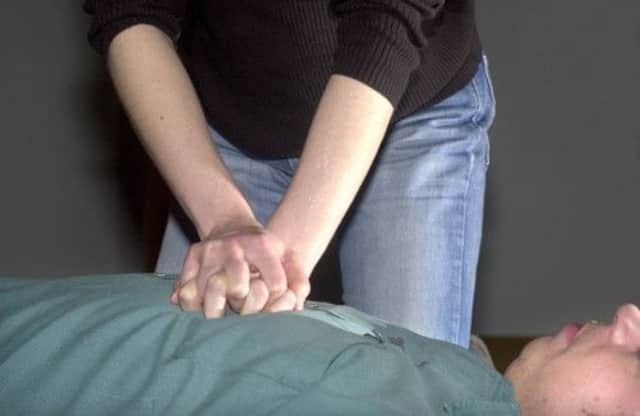We can cut the cardiac arrest death toll


Out-of-hospital cardiac arrest is the commonest life-threatening medical emergency in Scotland. It can affect anyone at any time, and often happens to people with no prior signs of ill health.
Cardiac arrest occurs when the heart suddenly stops pumping blood around the body. If this happens, you immediately lose consciousness and stop breathing, because your brain has lost its oxygen supply. If your heart isn’t restarted within minutes, you’ll almost certainly die.
Advertisement
Hide AdAdvertisement
Hide AdAlthough the exact numbers aren’t yet recorded, this happens to at least 3,000 people in Scotland every year. The Scottish Ambulance Service only records the number of patients whose hearts are effectively restarted at the scene. In 2011, this averaged 15 per cent across Scotland. Of those accounted for, 85 per cent of patients died at the scene of their arrest. Of those who survived to reach hospital, some died in hospital and others returned home with disabilities.
However, in Edinburgh the survival rate is nearly twice as high as a result of a unique partnership between emergency care specialists from Edinburgh’s Resuscitation Research Group, Scottish Ambulance Service paramedics and Chest Heart & Stroke Scotland (CHSS).
Chain of survival
Surviving an out-of-hospital cardiac arrest depends on a series of events occurring seamlessly: the “chain of survival”. This includes immediate recognition of the cardiac arrest and calling for help; early, effective cardiopulmonary resuscitation (CPR) and defibrillation at the scene; and the best possible specialist hospital care to allow the heart and brain to recover from the damage.
Each link in this chain has to operate effectively to give the patient the best chance of survival. In 2008, a programme of resuscitation research began in Edinburgh, supported by the Scottish Ambulance Service and funded by CHSS, which focused on each element in the chain of survival.
The key first link is early recognition of the event, calling 999 and starting CPR. In Edinburgh, 999 calls are downloaded from the Ambulance Control Centre and analysed to help ensure the best advice is given to those providing emergency resuscitation at the scene.
Once paramedics arrive, the quality of CPR provided to the patient is monitored using a range of equipment, including video recording and digital measuring. This is used to further train ambulance personnel to ensure the best possible delivery of resuscitation every time. The latest development is the use of mechanical CPR devices to ensure effective resuscitation throughout the ambulance journey back to the hospital. Once in hospital, the patient is looked after by emergency care specialists.
Potential to save 300 lives a year
It became clear from early in the programme that the best results were produced by specialist teams. Even in a busy city, the average paramedic would be called to only a handful of cardiac arrests in any one year. Having a small trained team was more effective in saving lives. This led to the formation of the Resuscitation Rapid Response Unit (3RU) in the Edinburgh area.
The survival rate in Edinburgh is now the best in Scotland, and the percentage of patients returning home after a cardiac arrest is among the highest in the UK. The Scottish Ambulance Service is considering a proposal to roll out the programme across all major urban areas, with a potential saving of 300 lives a year.
Advertisement
Hide AdAdvertisement
Hide AdMore remote areas present a particular challenge. Due to the distances involved, ambulance response times are inevitably longer and the role of early community resuscitation becomes even more vital. In Skye, voluntary group Lucky2Bhere, also supported by CHSS, has been remarkably successful in training members of the local community in CPR and in providing defibrillators. Lucky2Bhere is now expanding across all of north-west Scotland.
We need this type of education on a national scale. Evidence from Scandinavia and the United States shows that community CPR education programmes, particularly when provided in schools, are highly effective. We need to push forward with this in Scotland.
The survival rate from out-of-hospital cardiac arrest has improved in parts of Scotland, but is still highly variable. A key first step would be to establish a national registry of cardiac arrests so we are fully aware of the scale of the problem. Having demonstrated what can be achieved, we need urgent action to ensure the lessons learned from the successful community education and paramedic resuscitation programmes are rolled out across the whole country. There is real potential here to save thousands of lives.
• David Clark is chief executive of Chest Heart & Stroke Scotland; Dr Gareth Clegg & Dr Richard Lyon lead the Resuscitation Research Group at the University of Edinburgh